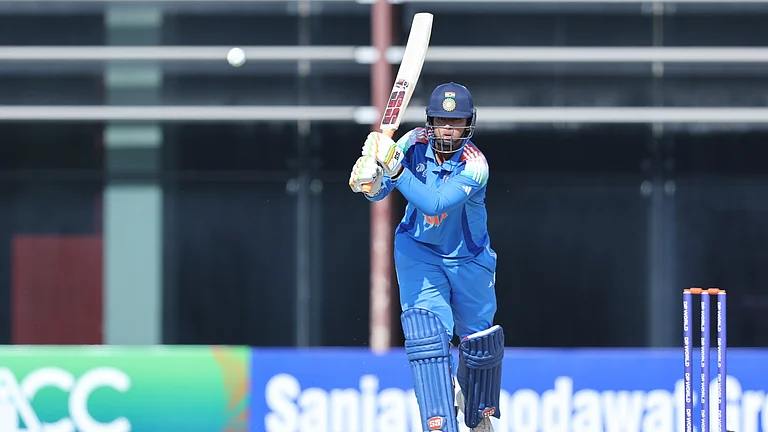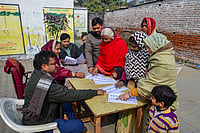With Diwali around the corner, Delhi's air quality has taken a familiar turn for the worse. On Sunday, the city recorded "poor" AQI for the eighth consecutive day on Sunday. The air quality is likely to turn "severe" on Diwali due to emissions from firecrackers and an increase in the share of smoke from stubble burning because of a favourable wind speed and direction.
The capital's Air Quality Index (AQI) stood at 243 at 10 am on Sunday. It was 265 at 4 pm on Saturday. Delhi's overall air quality is predicted to remain in the 'poor' to the lower end of 'very poor' category until the morning of October 24, according to the System of Air Quality and Weather Forecasting And Research (SAFAR).
The air quality might improve slightly on October 26 evening onwards to the lower end of 'very poor' category as surface winds will pick up on October 26 and stubble transport level winds will slow down.
An AQI between zero and 50 is considered "good", 51 and 100 "satisfactory", 101 and 200 "moderate", 201 and 300 "poor", 301 and 400 "very poor", and 401 and 500 "severe".
The bad air days come after an unusually clear and cool spell in Dlehi this year. An analysis by the Centre for Science and Environment (CSE) found that Delhi's PM2.5 pollution average for the July-August-September quarter this year stood at 37 microgram per cubic metre, only marginally higher than the five-year low of 36 microgram per cubic metre recorded during 2020.
Pollution levels in the July-August-September quarter were preceded by one of the most polluted summers this year, unlike in 2020 when the trimester followed the cleanest ever summer (March-May) duSo e to extraordinary conditions created because of hard pandemic lockdowns, the green think tank said.
Why air quality is likely to worsen
The annual pollution fiasco in the capital can be attributed to a cocktail of emissions from firecrackers and stubble burning, clubbed with geological and climatic challenges together contribute. Along with dust and biomass burning, vehicular emissions is also a major contributor to Delhi's pollution generated locally, as per the environment ministry.
Stubble burning: According to predictions by SAFAR, transport-level winds from Punjab, Haryana and Uttar Pradesh towards Delhi will pick up from October 24 and, in all likelihood, will bring significant stubble-related emissions to Delhi. "If stubble burning increases gradually, which is likely, its share in Delhi's PM2.5 (based on the average temporal variability of fire counts in the previous years) is likely to be 5 per cent on October 23, 8 per cent on October 24 and 16 to 18 per cent on October 25," SAFAR's predictions said.
Adverse weather: "Adverse weather conditions may bring firecracker-related pollution from surrounding regions of Delhi (outside NCT) and with 15 to 18 per cent stubble burning contribution, the AQI is predicted to touch the upper end of 'very poor' to lower end of 'severe' on October 25 (without emission from firecrackers in Delhi)," the predictions said.
Firecrackers: SAFAR has further predicted that in case there was emission from firecrackers, along with other factors, the AQI would worsen to 'severe' on Diwali (October 23) and might continue to remain the same for the next two days (October 24 and October 25). A survey on Saturday found ) The percentage of households bursting firecrackers in Delhi-NCR on Diwali could be the highest in five years as two out of every five families are likely to indulge in the activity.
Vehicular pollution: Vehicular emissions contribute the highest share to Delhi’s PM 2.5 levels, in terms of local sources of pollution, according to an analysis by the Centre for Science and Environment (CSE).
Delhi's plan to tackle pollution
Pollution-free Diwali: The Delhi government on Friday lit 51,000 diyas at Central Park in Connaught Place here to mark the launch of its campaign for a pollution-free Diwali.
Cracker ban: The AAP government in September re-imposed a complete ban on the production, sale and use of all types of firecrackers till January 1, a practice it has been following for the past two years.
Heavy penalty: Bursting firecrackers on Diwali in Delhi will attract a jail term of up to six months and a fine of Rs 200, Environment Minister Gopal Rai had said on Wednesday.
Strict implementation: A total of 408 teams have been set up to implement the ban. Delhi Police has set up 210 teams under assistant commissioners, while the Revenue Department has set up 165 teams. The Delhi Pollution Control Committee has constituted 33 teams.
'Red light gadi off': The Delhi government will launch the "Red Light on Gaadi off" campaign again to curb vehicular pollution from October 28, Environment Minister Gopal Rai told the press earlier this week. Under the campaign, first launched on October 16, 2020, to cut down vehicular pollution in the national capital, drivers are encouraged to switch off their vehicles while waiting for the traffic light to turn green.
GRAP: The Commission for Air Quality Management (CAQM) had on Wednesday directed authorities to enact Stage II of the Graded Response Action Plan (GRAP) -- a set of anti-air pollution measures followed in the national capital and its vicinity, according to the severity of the situation. The Stage II plan includes banning the use of coal and firewood in hotels, restaurants and open eateries. The use of diesel generators, except for essential services, is also banned.
Construction sector: Brick kilns, hot mix plants and stone crushers not operating on clean fuels and mining and associated activities in NCR will also be banned.
What is GRAP?
GRAP is classified under four stages, depending on the air quality in Delhi. Stage I is implemented in case of 'poor' air quality (AQI 201-300); Stage II for 'very poor' (AQI 301-400); Stage III for 'severe' (AQI 401-450) and Stage IV for 'severe plus' (AQI >450).
If the situation turns 'severe' (Stage III), authorities will have to enforce a ban on construction and demolition activities in NCR, except on essential projects (such as railways, metros, airports, ISBTs, national security/defence-related projects of national importance) and non-polluting activities such as plumbing, carpentry, interior decoration and electrical works.
Under Stage IV, four-wheeled diesel light motor vehicles, except BS-VI and those engaged in essential services, will also be banned in Delhi and bordering districts of NCR.
Stage IV will also trigger a ban on industries running on dirty fuels and construction and demolition activities in linear public projects such as highways, roads, flyovers, over bridges, power transmission and pipelines.
(With inputs from PTI)


























